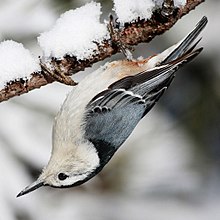White-breasted nuthatch
In summer, it is an exclusively insectivorous bird, consuming a wide range of arthropods, but in winter its diet consists mainly of seeds.
The nuthatches are a genus, Sitta, of small passerine birds which derive their English name from the tendency of some species to wedge large insects or seeds into cracks, and then hack at them with their strong bills.
[9] A study published in 2012 showed that four distinct lineages were genetically isolated from each other and could represent different species, recognizable by morphology and song.
[9] The female has, on average, a narrower black back band, slightly duller upperparts and buffer underparts than the male.
In the northeastern United States, at least 10% of females have black caps, but the proportion rises to 40–80% in the Rocky Mountains, Mexico and the southeastern U.S.
[9] Three other, significantly smaller, nuthatches have ranges which overlap that of white-breasted, but none has white plumage completely surrounding the eye.
These groups cover eastern North America, the Great Basin and central Mexico, and the Pacific coastal regions.
[9] The eastern form also has a thicker bill and broader dark cap stripe than the interior and Pacific races.
In the eastern part of its range, its preferred habitat is old-growth open deciduous or mixed forest, including orchards, parks, suburban gardens and cemeteries; it is found mainly in the lowlands, although it breeds at 1,675 m (5,495 ft) elevation in Tennessee.
One bird landed on the RMS Queen Mary six hours' sailing east of New York City in October 1963.
[18] The white-breasted nuthatch is monogamous, and pairs form following a courtship in which the male bows to the female, spreading his tail and drooping his wings while swaying back and forth; he also feeds her morsels of food.
[9] The nest hole is usually 3–12 m (9.8–39.4 ft) high in a tree and is lined with fur, fine grass, and shredded bark.
The contact call between members of a pair, given most frequently in the fall and winter is a thin squeaky nit, uttered up to 30 times a minute.
A more distinctive sound is a shrill kri repeated rapidly with mounting anxiety or excitement kri-kri-kri-kri-kri-kri-kri-kri; the Rocky Mountains and Great Basin subspecies have a higher, faster yididitititit call,[9] and Pacific birds a more nasal beeerf.
[13] The white-breasted nuthatch forages along tree trunks and branches in a similar way to woodpeckers and treecreepers, but does not use its tail for additional support, instead progressing in jerky hops using its strong legs and feet.
All nuthatches are distinctive when seeking food because they are able to descend tree trunks head-first and can hang upside-down beneath twigs and branches.
[19] The nuthatch may also smear blister beetles around the entrance to its nest, and it has been suggested that the unpleasant smell from the crushed insects deters squirrels, its chief competitor for natural tree cavities.
[30] The white-breasted nuthatch can also be the target of hematophagous flies of the family Hippoboscidae, such as Ornithoica confluenta and Ornithomya anchineuria[31][32][33] or of certain mites, such as Knemidokoptes jamaicensis, which produces scabies.
[1] The removal of dead trees from forests may cause problems locally for this species because it requires cavity sites for nesting; declines have been noted in Washington state, Florida, and more widely in the southeastern U.S. west to Texas.
In contrast, the breeding range is expanding in Alberta, and numbers are increasing in the northeast due to regrown forest.
[9][35][36] The white-breasted nuthatch is protected under the Migratory Bird Treaty Act of 1918, to which the three countries in which it occurs (Canada, Mexico, and the United States) are all signatories.



